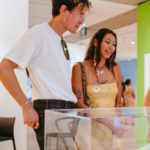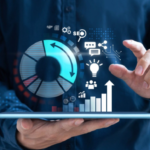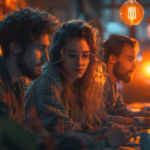Introduction
Art is a language that transcends boundaries. It communicates emotions, tells stories, and challenges perceptions. But what happens when the timelessness of art collides with the cutting-edge technology of artificial intelligence? The result is andywarhella, an innovative concept where art and AI create a dialogue that reshapes how we understand creativity, culture, and technology. This fusion brings forth questions about the nature of artistry and its role in a tech-driven future.
The Rise of AI in Art
Understanding Artificial Intelligence in Creative Fields
Artificial intelligence has made significant strides in recent years, with applications in healthcare, finance, automation, and, more recently, the arts. From painting to music to literature, AI is proving its ability to mimic and even enhance human creativity. Tools like generative adversarial networks (GANs) allow machines to generate art based on datasets of existing works, creating pieces that can surprise and inspire.
andywarhella, for instance, leverages AI not just as a tool but as a collaborator in the artistic process. By doing so, it redefines what it means to be an artist in the 21st century.
Key Benefits of AI in Art
AI’s influence in art offers several advantages:
- Efficiency: AI algorithms can process vast amounts of data in minutes, allowing for quicker creation processes.
- Exploration of New Styles: By analyzing millions of artworks, AI can create hybrids of styles no human artist may have conceived.
- Accessibility: Tools like andywarhella make art creation more accessible to novices who want to experiment with creativity without formal training.
What Is andywarhella?
At its core, andywarhella is a platform that merges AI with artistic creation. It’s reminiscent of Andy Warhol’s revolutionary pop art movement but reimagined for the digital age. The name itself is a playful nod to the legendary Warhol, whose work explored the intersection of culture, mass production, and individuality—in ways similar to how AI approaches art today.
Features of andywarhella
-
AI-Assisted Creations
With andywarhella, users can upload their inspirations, whether images, text, or even sound, and watch as the platform generates art that merges human input with machine intelligence.
-
Style Fusion
The platform excels in blending classic artistic styles with futuristic aesthetics. Imagine a Van Gogh-inspired piece with digital glitches or a Picasso-like abstraction rendered in vibrant modern palettes.
-
Collaborative User Interface
More than just a tool, andywarhella encourages collaboration. Multiple users can input ideas, and the AI synthesizes them into cohesive works of art.
-
Democratized Art Creation
One of the most empowering aspects of andywarhella is its accessibility. You don’t need to be an artist or a tech expert; the intuitive interface lets anyone experiment with the wonders of art and AI.
The Intersection of Creativity and Technology
How AI Generates Art
AI isn’t magic; it relies on data. Algorithms analyze thousands (or millions) of existing artworks to learn patterns, textures, colors, and compositions. The process of generating art can be broken down as follows:
- Data Training: AI is fed curated datasets of artworks, helping it “learn” various styles.
- Generative Modeling: Algorithms like GANs or neural networks synthesize these patterns to create original pieces.
- User Interaction: With platforms like andywarhella, users customize parameters—style, color scheme, subject matter—for personalized output.
Redefining Creativity
Critics often argue that AI cannot “create” in the human sense. Creativity, they insist, comes from emotions, experiences, and the soul of the artist. However, platforms like andywarhella challenge this notion by combining human intention with machine precision. Does the origin of creativity matter as long as the art moves its audience?
Real-Life Examples of AI-Generated Art
A Sotheby’s Auction Sensation
One of the most publicized examples of AI in art was when “Edmond de Belamy,” a portrait generated by AI, was auctioned at Sotheby’s in 2018 for $432,500. This milestone emphasized the growing value of AI-generated art in traditional art markets.
The Influence of andywarhella Users
Take Jane Doe, an elementary school art teacher who used andywarhella to teach her students about abstract styles. By inputting their doodles, Jane collaborated with AI to turn them into gallery-worthy pieces, teaching children about creativity in the digital era.
Challenges and Ethical Questions
Despite its advances, AI in art raises ethical and philosophical debates.
- Authenticity: If an AI creates the art, who owns it? Is it the programmer, the platform, or the user providing input?
- Job Displacement: With AI platforms simplifying the artistic process, could traditional artists find themselves overshadowed?
- Cultural Appropriation: If an AI borrows too heavily from existing works, does it risk perpetuating uncredited influences or biases?
Platforms like andywarhella address these concerns through transparency, ethical guidelines, and ensuring that AI complements human creativity instead of replacing it.
Tips for Using AI Platforms like andywarhella
- Start Small: Begin with foundational experiments by inputting simple designs or concepts.
- Experiment Boldly: Push boundaries by mixing contrasting styles or themes.
- Stay Collaborative: Encourage peers or communities to join your process for diversified input.
- Acknowledge AI’s Role: Be transparent when sharing your work, ensuring credits reflect the collaborative nature of creation.
Why andywarhella Spearheads the Art-AI Movement?
The success of andywarhella lies in its philosophy. It’s not just about creating aesthetically pleasing pieces but opening a dialogue about humanity and technology. Here’s what sets it apart:
- Core Mission: Celebrating human potential amplified by AI.
- Inclusivity: People from all backgrounds can contribute.
- Community Driven: Regularly updated based on user feedback and trends, ensuring relevancy and innovation.
The Future of Art-AI Collaborations
The marriage of art and AI is still in its infancy. Over time, platforms like andywarhella could redefine galleries, museums, and even how we value artistic expression. Imagine interactive exhibitions where visitors create art in real time or AI restoring damaged historical works with unprecedented precision.
One possible scenario is the rise of hybrid artists—not just humans or AI, but partnerships between the two. These collaborations could lead to masterpieces that neither party could achieve alone.
Final Thoughts
The intersection of art and AI, embodied by andywarhella, represents a turning point in creative history. It challenges us to rethink artistic ownership, creativity, and human-machine partnerships. By bridging centuries-old traditions with cutting-edge tools, andywarhella isn’t just a platform; it’s a movement that invites everyone to be part of the future.





